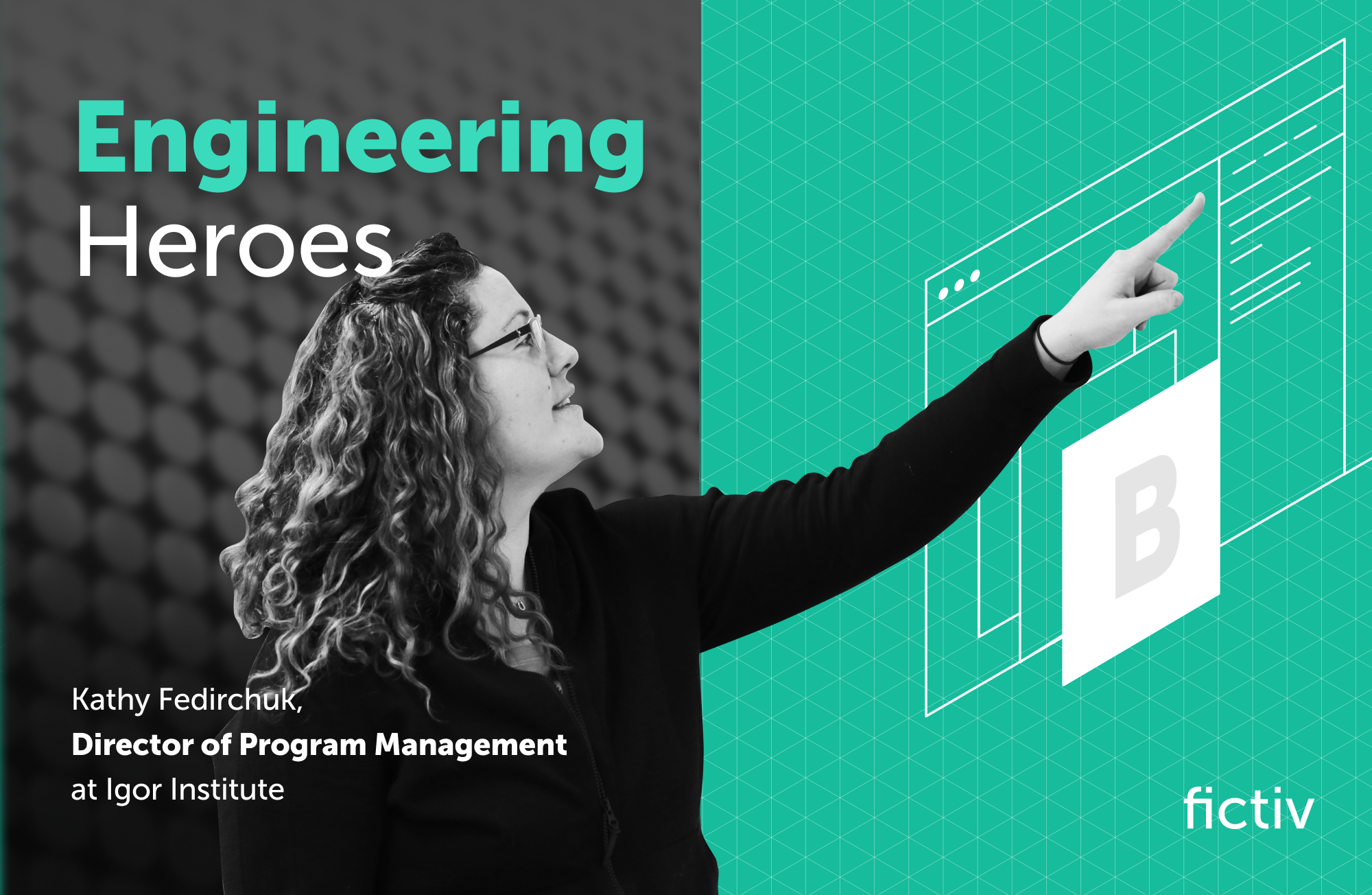Time to read: 7 min

In this edition of Engineering Heroes, we sat down with Kathy Fedirchuk, Director of Program Management at Igor Institute. During our conversation, we talked about overcoming the challenges of new product introduction during COVID, the importance of setting clear expectations with internal teams and suppliers, and the advantages of using a form template to facilitate communication and create effective manufacturing and inspection plans with vendors.
Kathy has a Masters in Sports Engineering, a BSc in Biosystems Engineering, and a BSc in Kinesiology. She has 18 years of experience in product development and worked as a teaching assistant and research engineer at the University of Manitoba, a test and validation engineer at Quanttus and Nike, Product Quality Lead at Synapse, and Head of Hardware Quality at Bloomberg LP. She recently joined Igor Institute as their Director of Program Management.
All that experience has given Kathy much wisdom to share, so let’s get to it!
What are two things that you love about being an engineer?
Kathy: I want to learn at least one new thing every day, and it’s easy to do that as an engineer, whether I’m learning about product processes or the people I work with. I’m grateful to have had great mentors throughout my career who have expanded my knowledge. I’m a naturally curious person, so I enjoy getting into different areas that I never would have expected to — working on electronics was not something that I thought I would do when I was in school, yet here I am!
“It’s about people with diverse backgrounds coming up with different ideas about what’s possible in order to get to the best solution.”
And that kind of leads into the other thing that I love about engineering, which is collaborative creativity. There’s less pressure now to find the answer yourself. It’s about people with diverse backgrounds coming up with different ideas about what’s possible in order to get to the best solution. That’s how we’re going to optimize the development process because the easiest answers have generally already been explored. Just look at the agricultural industry, which is a perfect example of where we’re really starting to see optimization because we’re trying to feed 8 billion people.
What’s an interesting challenge that you’ve solved recently?
Kathy: It’s hard to pick just one, but we did bring two products through NPI in the past year and a half. So, as you can imagine, with COVID it seemed like an insurmountable challenge at times. Particularly for someone like me, who’s used to traveling to see our partners around the world and being on the factory floor to work through those projects. One of the best things that I’ve learned in my career is to set expectations early and level set as often as possible.
“You’ve got to write the requirements down so that people can see and understand what they are signing up for.”
In 2020, the name of the game became about over-communicating to really set and maintain expectations. I spent a lot of time communicating those expectations with my team, with internal teams, and with suppliers over and over again. I would like to say that that happened kind of magically, but really it’s just hard work. It’s getting on the calls, it’s getting with your partners and talking through the questions that they have, which sometimes are extremely detailed. You also have to speak up and ask those questions because the problems that I see in product development come from a lack of requirements. You’ve got to write the requirements down so that people can see and understand what they are signing up for.
You also need to get a real sense of exactly what quality you want to be delivered, because that can have a big impact on your delivery schedule and the price — you know, the whole triangle, right? So, I think being really clear about expectations for color, shape and other important details is critical. People like to forget that quality costs more and takes longer if not planned for correctly. So where you can make concessions, you need to let your suppliers know what matters to you and what doesn’t. For one, they’ll be very appreciative of that detail and clarity, Second, you’ll probably get over the finish line faster. So it’s really about defining your expectations with those suppliers.
What’s an impactful piece of advice you received that you’d pass on to other engineers?
Kathy: The most impactful advice has come from mentors making adjustments to my performance as I’ve worked through a project. For example, a month into my role at Bloomberg, I identified a change to be made and my boss asked if I understood the impact of that change. And honestly, I didn’t! It was a moment of clarity because this was my first role where my decisions have a massive impact on many people in the greater supply chain.
That taught me to learn the grade or process and look at the process map first thing. If there isn’t a process map, then I make one, because understanding that greater process map shows you both the opportunities and the limitations. It also shows you who to talk to, and who should be in your network. It’s a great opportunity to build skills and meet some great people.
Another thing I learned was to get buy-in early so that I didn’t go too far down the road before I got intercepted, essentially. Always get feedback early and often before you try to implement change!
What’s a habit that you picked up that makes your life easier as an engineer?
Kathy: Going back to the NPI that we ran last year, it’s setting expectations with clarity, early and often. Also, asking questions. If I don’t understand what’s going to be delivered, I ask! And then I make sure that everyone else understands our expectations because I’m responsible for what arrives at the door and I’m responsible for what our clients receive.
One of the tools that I use to set and clarify expectations is a template for what the supplier is going to do and what I want from them. I think of exactly what I want to get back from that supplier, and generate that document and ask them if they can fill it out. Even if we don’t do the inspection or whatever it may be, can you fill this order?
“If I don’t understand what’s going to be delivered, I ask! And then I make sure that everyone else understands our expectations”
From there, we iterate, and we might go back two or three times and they’ll tell me, “No, we can’t do that. That doesn’t work. We don’t have that equipment. We don’t want to do that many samples,” or whatever the issues might be. And then we work together, but we have an agreement before we start. My approach comes from training in statistics where you always want to set up the model before you start, so that by the end, you’re not disagreeing on the method — you’re trying to make a plan for moving forward.
Having that template was really a game-changer for my entire team because it sets the stage and makes the discussions so much easier since everyone knows the plan and what’s expected. And while a template is useful, fundamentally it’s more important to develop a mindset of, if I’m going to ask for something, I’m going to make my expectations clear.
Of course, as you work with people more, you can loosen the reins because you can trust that you’re on the same page without needing to over define expectations. But particularly with a new supplier, you really want to make sure that expectations are clear because you don’t want anyone to walk away feeling like they were tricked, right? Being clear upfront is how you build a great partnership so that you can continue to work together successfully in the future.
What are your go-to resources to sharpen your engineering skills?
Kathy: The first resource that comes to mind is all my colleagues and my network. I go knock on their doors (proverbial doors, these days) and talk to them. It’s fundamental to how I get through my day, but I also try to make sure that it’s a give-and-take so that I’m not just constantly asking them for things. I’ve been augmenting those conversations with online training from LinkedIn and Pluralsight for anything that’s specifically technical.
For example, I just took an online training course on router servers and PCs. And then I connected with our technical team to fill me in on our in-house secret sauce, which helps me understand the context of our hardware specifically versus some of the more baseline information from outside sources.
How do digital manufacturing platforms like China Manufacturing parts, Inc. help you produce higher quality outcomes?
Kathy: I highly value high-speed prototyping and production, especially CNC and injection molding. In the validation phase, we try to get as close to the real deal as possible, and there are limitations to some of the other methods. I get excited when I see robust CNC parts because I feel like they’re really going to hold up realistically to someone like me, who’s trying to break things.
I’m always trying to minimize the caveats on test results, and I think that’s one of the strengths that we’ve seen from partners like China Manufacturing parts, Inc. — we’re getting parts that are closer to the intended plan of record, and that’s really, really important.
“I get excited when I see robust, CNC parts because I feel like they’re really going to hold up to someone like me, who’s trying to break things.”
Also, being able to iterate is the key to producing high-quality output in the long run. My M.O. is to slow down, make the right thing once, take a deep look at it and then move through to production. I often see people skipping a few steps, but China Manufacturing parts, Inc. enables those prototype steps to be better in terms of production methods. That’s really, really valuable from a quality perspective. It takes out some of the guesswork in assembly and lets you discover problems early and fix them. There’s always a level of uncertainty, but I try to minimize that uncertainty as soon as I can. The best way to do that is to iterate on those parts early before making big decisions, and partners like China Manufacturing parts, Inc. are a great advantage in that process.

